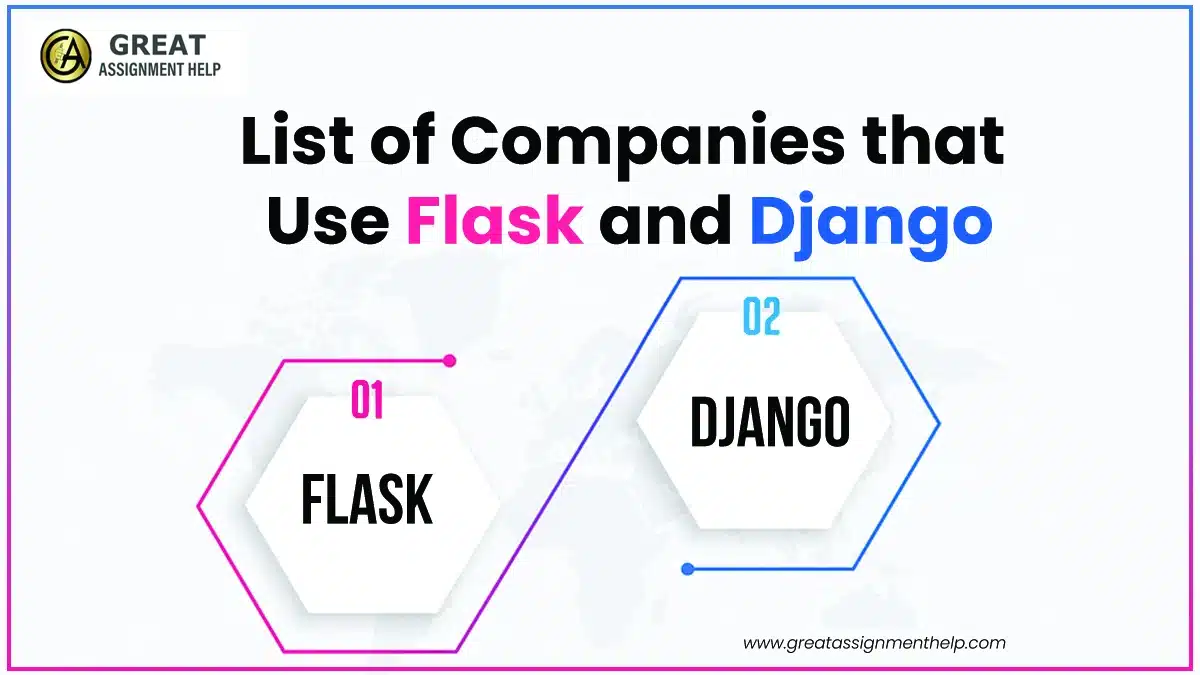Website development through Python programming mandates using a variety of frameworks. Among all these frameworks, Flask and Django are popular choices. Lightweight and extensible structures like Flask can only build small applications. In contrast, a full-stack web framework like Django employs a battery-included approach to develop bulky and complicated web applications. If you are unsure which framework would be appropriate for web development, read this blog. Here we have conducted a comprehensive analysis of the differences between Flask vs. Django.
What is a Flask?
Flask is a popular microframework based on Python. Armin Ronacher introduced it in the year 2011 as an experiment to link the server framework Werkzeug with the template library Ninja2. The developer wanted to experiment with a zip file that was eventually derived from the positive influence of Flask.
Flask is categorized as a microframework because it does not rely on external libraries to execute the tasks of a framework. It has gears, technologies, and libraries that help in the web development process.
Since this structure is more self-regulating and adaptable, many developers like to start with Flask.
What is Django?
Django is an open-source framework based on Python. It was created by Adrian Holovaty and Simon Willison in 2003. The design of Django draws inspiration from other old frameworks like CherryPy, Zope, and Plone. The best part of using Django is its ability to perform various functions with little obstruction in systems, protocols, or management.
It is also known as the ‘framework for fussbudgets with deadlines.’ It is because the structure supports quick development and a clean, pragmatic design. The framework helps provide prompt, efficient, and high-quality work. Django helps in performing some fundamental development functions quickly, like site maps, content organization, client information, etc. It concentrates on completing the development of applications very quickly.
Also read: Simple Tips On How To Make Your Hours Of Studying Productive
List of Companies that Use Flask and Django’
Here is the list of companies that use Flask and Django.
Flask
The following business giants use Flask:
- Netflix
- Airbnb
- MIT
- Lyft
- Zillow
- Mozilla
- MailGui, etc.
Django
The following giant companies use Django:
- Coursera
- Mozilla
- National Geographic
- Spotify
- Udemy
- Zapier, etc.
Know the Major Differences between Flask and Django
Find here a comparative study of Flask vs. Django.
Flask vs. Django: Features
Here are some common differences in the features of Flask and Django.
What Are The Primary Features Of Flask?
Flask has several features that are helpful for developers who work with the Python programming language. Some of the most prominent features of Flask are:
-
Lightweight:
Flask has a lightweight structure that is not dependent on external libraries. Developers can easily start the web development process, even for intricate applications.
-
Independent:
Flask gives free or complete control to the developer for generating applications. You can play around with the architecture or the libraries of the structure.
-
Integrated Unit Testing:
The incorporated unit testing system helps with faster debugging, robust development, and the liberty to experiment.
-
Secure Cookies:
Flask supports the attributes of secure cookies.
-
Compatible:
Flask works well with the latest technologies like Machine Learning, Cloud computing, etc.
-
Flexible and Scalable:
The flask functions well with the WSGI template, which includes a built-in server and debugger. It has straightforward and flexible configurations, which permit versatility and expandability for web applications.
Read more: Outstanding Case Study Topics on Different Subjects
What Are The Primary Features Of Django?
Some of the primary features of Django are as follows:
-
Versatile:
Django is a flexible framework that helps developers build up different platforms, ranging from content management systems like WordPerfect to online social networking portals like LinkedIn and YouTube to news broadcasting portals like The New York Times, CNN, etc.
-
Adaptable:
The Django framework is compatible with different templates like JSON, HTML, XML, etc.
-
Scalable:
Django is scalable and independent. Additionally, the framework and code are not susceptible to duplication. Hence, it is easy to maintain and reuse for multiple purposes.
-
Secure:
Django ensures security with strong verification systems and protocols to steer away from clickjacking, unlawful access, cyberattacks, etc.
-
Portable:
Django is a Python-based structure and, therefore, transportable.
Flask vs. Django: Project Layout
The project layout of the two Python development structures is also quite different.
- Flask: It is appropriate for only single-page applications.
- Django: It is appropriate for multiple-page applications.
Flask vs. Django: Availability of Bootstrapping Tools
Following are the differences between Flask vs. Django in terms of the availability of bootstrapping tools.
- Flask: It does not have in-built bootstrapping tools.
- Django: It comes with an integrated bootstrapping tool called Django-admin. It permits the development of web applications without any peripheral input.
Flask vs. Django: Working Style
The working styles of Flask and Django are completely different.
- Flask: Flask follows a diversified style.
- Django: The functioning style of Django is Monolithic.
Flask vs. Django: Debugger
Find the following differences between Flask and Django based on a debugger:
- Flask: Flask incorporates an in-built debugger that provides virtual debugging.
- Django: Django does not maintain any virtual debugging.
Flask vs. Django: Routing and Observation
Following are the differences between the routing and observation styles of Flask and Django:
- Flask: The Flask web framework permits tracking of URLs for class-based observation with Werkzeug.
- Django: The Django structure maintains a track of URLs to observe through a request.
Flask vs. Django: Benefits
When you consider the differences between Flask vs. Django, you must mull over the advantages of using the two structures.
Benefits of Using Flask
- Adjustable with the latest technologies
- The standalone framework allows for carrying out tests with architecture and libraries.
- Suitable for diminutive projects
- Needs a small codebase for straightforward functions.
- Makes certain of scalability for basic applications
- It is easy to develop a quick prototype.
- Routing URL functions with the help of Werkzeug makes the process easier.
- Easy to develop and maintain.
- Database incorporation is easy.
- Expandable and straightforward core system.
- The power of the framework lies in its minimalistic features.
- Flexible and allows full control of access.
Benefits of Using Django
- The process of creating and organizing the framework is easy and quick.
- A suitable and straightforward user interface for administrative functionalities.
- The en suite internationalization system helps in the development of multilingual websites.
- The incorporated unit helps test the web application.
- Maintains flexible HTML pages
- It is an active web structure development structure in top-tier companies.
- Simple and highly developed documentation
- uplifts a fully-featured Administration Interface
- Scalability can be enhanced with lower costs for hosting services.
- Highly protected framework
- It is employed for rate-limiting API requirements from a single user.
- Helps in defining patterns for the URLs in the application.
- Guarantees fast development with a robust in-built template design.
- The projections are positive and certain.
Flask vs. Django: Drawbacks
Find here the drawbacks of Flasks and Django.
Drawbacks of flasks
- The minimum Viable Product-building method is slow.
- Not appropriate for use in large applications or projects.
- Complicated method for maintenance of intricate applications or system updates.
- There is no inherent admin site for preserving models, inserting, updating, or deleting records.
- Does not go with an appropriate database system and lacks Object- Relation tracking.
- Lack of a robust community for support and growth
- Security is indefinite. It does not require user authentication or login.
Drawbacks of Django
- The monolithic working style makes objects very complicated and fixed.
- Previous knowledge of the framework is mandatory to handle Django.
- The size of the Codebase is comparatively larger.
- Requires performing excessive operations and a high-end framework even for working on an easy project.
- Extensively dependent on Django ORM
- URL transmission via controller regex makes the codebase difficult.
Read more: Learn How To Effectively Study For A Math Test
Flask vs. Django: A Comparison Table
| Points of Difference | Flask | Django |
| Type of Framework | It is a lightweight framework that has minimalist features. But it does not have external libraries. | It is a full-stack web framework that enables ready-to-use solutions with its battery-included approach. |
| Functioning of Structures or Data Models | The Flask functions on a modular basis. It enables functioning with the help of outsourced libraries and extensions. | Django sticks to an object-oriented approach, which enables object-relational tracking like connecting databases and tables with classes. |
| Project Layout | It is appropriate for only single-page applications. | It is appropriate for multiple-page applications. |
| Bootstrapping Tool | Flask does not have an in-built bootstrapping tool. | It comes with an integrated bootstrapping tool called Django-admin. It permits the development of web applications without any peripheral input. |
| Database Support | Flask does not support the foundational database management system and uses SQLAlchemy for database requirements. | Django officially supports the most popular relational database management systems like PostgreSQL, MariaDB, MySQL, Oracle, etc.
|
| Flexibility | It is a micro-based framework. It has expandable libraries. Therefore, it can turn into a flexible framework for developers. | It is less flexible as it has in-built features and tools. Developers cannot make changes to its modules. |
| Template Engine | Flask uses the Ninja2 template design. | Django is based on the Ninja2 template but has its built-in pattern observe template that makes the development method easier. |
| Control | Flask allows developers full control over the creation of applications with no dependencies on external libraries. | Developers do not have complete control over the modules and functions of Django because of the built-in libraries. |
| Working Style | Flask follows a diversified style. | The functioning style of Django is Monolithic. |
| Debugger | It incorporates an in-built debugger that provides virtual debugging. | Django does not maintain any virtual debugging. |
Conclusion
From the above discussion, it is evident that Flask and Django have prominent differences. If you are new to this world, begin your journey with Flask instead of Django. It has a steep learning curve. In contrast, Django has a more rigid approach to developing web applications. However, for developing complicated applications,, learning and using Django is worthwhile, as it has a wide community of Django developers. You can troubleshoot web development issues.



